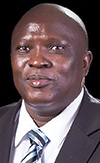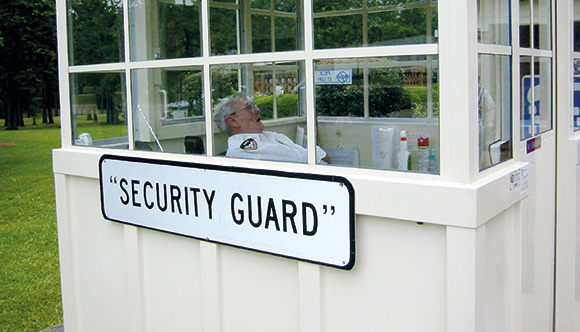
A common sight throughout South Africa, whether you’re in a residential area, a mall or a business location is the sight of guards of various sorts manning their posts, patrolling transporting cash and valuables, and occupied in a host of other duties. Due to the proliferation of crime of all sorts in the country and the seeming inability or unwillingness to address the issue from national leadership, private security is big business in South Africa and arguably the largest employer in the country.
In this issue of Hi-Tech Security Solutions, we look at what companies are experiencing in the delivery of their guarding services. This, of course, is divided into two aspects: what the customer wants and what the customer can get. It’s the job of the security, facility or operations manager in businesses to juggle these two realities and come up with a solution that works.
Part of this balancing act is the decision to either outsource your guarding to a service provider or keep the function in-house, training and managing your own guards, or to opt for some form of hybrid in-and-out solution. Outsourcing always seems to be the best option given the complexities in building and managing your own guard force, but insourcing allows the business more control over what happens, who is in control and who is working on your premises. But is that reasoning too simplistic for the modern security operation?
Juan A. Badenhorst heads up security for an automotive dealership in South Africa. He says, “Our automotive dealership one of the largest independently owned in the world and we take security as seriously as selling vehicles, services and automotive parts. That was why we outsourced our guarding services completely. The reason is simple; it’s more advantageous for us.”

The advantage is that the company now only needs two in-house security staff-members to manage and maintain its security. All the risk, insurance, personnel administration and security logistics is the burden of the security service provider.
“Taking all the PSiRA regulations on compliance alone into account is enough reason to outsource completely,” he adds. “Our speciality lies in automobile sales and services. To ensure we can stay ahead of the pack, we outsource the rest to the best in their respective fields, including security services, to establish a secure sales environment for our customers.”
Mpho Kewakae, head of security at diamond mining company, Debswana, located in Botswana, also outsources, but notes that a major component of the company’s security is kept in-house.
“To have a meaningful decision and understand the business risk profile, an in-house risk assessment was conducted,” Kewakae explains. “As part of the risk assessment, assets were identified, analysed and priorities were formed based on their criticality (risk rating) from low, to medium and high risk.

“We are a diamond mining company and our processes are regulated by legislation (such as the Precious and Semi-Precious Stones Act), including having government gazetted and approved practitioners doing critical duties. Based on this assessment, only the low risk areas were outsourced at guarding level; the supervisory level remains in-house.”
Kewakae also notes that whether the job is outsourced or not, the accountability can’t be handed over to someone else. “Accountability remains with the in-house management. Even in instances where non-compliance is recorded against the outsourced guarding company, the owner is still accountable.”
Risk assessments are done annually as part of the security management processes at the automotive dealer, but security is seen as an open and working document that is updated as perceived security threat/s evolve. Badenhorst says assessments are done by himself and the service provider, and then compared to provide a better perspective on the current security threat analysis.
Replace humans with technology?
The question of technology replacing humans is always raised by some people, usually those selling technology. When using cameras and video analytics, for example, you are not restricted by shifts or differences in performance, or even someone having a bad day. Your technology should perform at optimal efficiency at all times (in theory). Is this realistic? What do the people ‘in the trenches’ think about technology as something that can replace the human guarding component?
Kewakae sees guarding as essential, but he says technology remains an invaluable aid and enabler. “Our regulations talk to ‘searches’, which can only be achieved by guards, and where appropriate, with the aid or technology either using baggage X-ray or through the use of CCTV to indicate targeted areas of search,” he states. “Being largely safety and security driven, what remains unseen by personnel in either real time or through analytics is uncovered by CCTV.
“Non-conformances are followed up for remedial action and fed into our very effective ‘near hit’ programme using CURA. Combining technology yields the results we need as a large part of our operation and we use a combination of data sources for effective analytics.
“Our feeling is that guards cannot be replaced, they remain an essential part of the layered security solution.”
Badenhorst agrees. “Both manned guarding and CCTV technology are necessary to make up the whole state of security. Each plays an essential and important role to establish and maintain a secure environment for our clients and customers to conduct business without fear or loss.”
He additionally believes guarding is not only an essential part of any security posture, but has many added benefits. “Technology, well applied, is a credible addition to enhance the function, performance and effectiveness of security officers. Combining guards with a CCTV monitoring component is like having two cameras facing each other with an added alarm function. They have ‘got each other’s back.’
Supporting this, Kewakae adds: “In order to implement our risk management regime, we have a lot of no-go and restricted high-risk areas that are covered by access management, intrusion alarms and CCTV. That said, they are only as good as the time it takes for us to assess and send a response to investigate and close any matters arising. Therein is the balance.”
Management via technology
Another use of technology is to keep an eye on what your human resources are doing. Regular readers of Hi-Tech Security Solutions will have seen a number of products and solutions designed to manage guards, from assigning shifts, making sure they are where they are supposed to be, and even keeping them safe from attacks.
There is no specific technology used to monitor guards at Debswana. Kewakae says the relationship between the employer and the guards is based on the understanding of post objectives and trust, plus regular meetings to effect short control intervals.
“There is an on-boarding induction and a rigorous awareness programme that customises the guards’ thinking to the requirements of the organisation,” he says. “As part of the deliverables, there are regular reports at the end of every shift and handing over to the oncoming shift. Random inspection is performed by the supervisory team.”
Additionally he notes that the guards subscribe to the requirements of the regulatory body in the country of operation. Certificates of affiliation are provided and minimum qualifications are enforced.
Similarly, human checks are part of Badenhorst’s security process. He says his company makes use of CCTV and Sentinel to monitor security officer performance and they also do regular spot checks to evaluate the performance thereof. “We use CCTV to ensure the system is used properly for full effect.”

Customising services and problem resolution
In any outsourced service provisioning scenario, the customer will always require more than the basic services offered. The requirement is then the ability to work with the service provider in creating the desired solution, which will include problem resolution processes.
And problems are a given in most situations and need to be dealt with and challenges need to be met with positive attitude in order to resolve them as soon and effectively as possible, says Badenhorst.
“Guards pose unique challenges and are almost always the greater of the two weaknesses in your security chain. Guards are susceptible to an array of distractions, including tiredness, sickness, cellphone communication, laziness, rebelliousness, destruction of property and negativity, to name a few. All of these issues can be dealt with if approached in a professional manner. They will respect what you inspect – so do it regularly.”
With guarding it is not always true that ‘you get what you pay for’. Badenhorst is of the view that how you manage your security detail will determine your outcomes. “Make sure you choose a company that complies with security standards and national regulation, and more than half your problems are solved.”
“Relevant skills deficit, absenteeism and rotation of deployed guards continues to be a challenge,” according to Kewakae. However, he notes that as a premium company, Debswana is happy with what it pays for guarding services and this is carefully negotiated on a win-win basis.
Improved services possible
As noted above, no service provider will be able to deliver exactly what every customer wants. To be able to offer a better service, Kewakae advises that the service provider can improve their offering by understanding the business and understanding the security strategy, culture and what the deliverables are. “There should be an agreed target, understood by all parties and signed off. The review dates should be agreed upon by the two parties. More importantly, partnering in some workshops and training is essential to keeping both parties relevant to the times.”
Badenhorst’s advice is firstly to be PSiRA compliant, and secondly to engage in and encourage feedback to constantly keep on top of the service and where it may need improvement.

© Technews Publishing (Pty) Ltd. | All Rights Reserved.